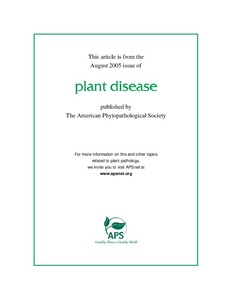| dc.contributor.author | Navi, S. |
| dc.contributor.author | Bandyopadhyay, Ranajit |
| dc.contributor.author | Reddy, R. |
| dc.contributor.author | Thakur, R. |
| dc.contributor.author | Yang, X. |
| dc.date.accessioned | 2019-12-04T11:18:38Z |
| dc.date.available | 2019-12-04T11:18:38Z |
| dc.date.issued | 2005 |
| dc.identifier.citation | Navi, S., Bandyopadhyay, R., Reddy, R., Thakur, R. & Yang, X. (2005). Effects of wetness duration and grain development stages on sorghum grain mold infection. Plant Disease, 89(8), 872-878. |
| dc.identifier.issn | 0191-2917 |
| dc.identifier.uri | https://hdl.handle.net/20.500.12478/3276 |
| dc.description.abstract | Grain mold caused by a complex of fungi is an economically important disease of sorghum worldwide. Little is known about the epidemiology of sorghum grain mold, which is essential for its management. Studies were conducted to quantify the effects of wetness duration on grain mold development under controlled conditions at ICRISAT. Six major sorghum grain mold fungi determined from previous field experiments, Curvularia lunata, Cladosporium oxysporum, Bi-polaris australiensis, Fusarium moniliforme, F. pallidoroseum, and Phoma sorghina, were used. Panicles of a pot-grown mold-susceptible sorghum line, IS 10513, were spray inoculated with each fungus at five growth stages: flowering (F), milk (M), soft dough (S), hard dough (H), and physiological maturity (P), and were incubated in dew chambers for 0, 16, 24, 40, 48, and 72 h. Then, the plants were placed on greenhouse benches at 25 ± 1°C to allow grain mold infection to develop. Eight days after treatments, grains from F, M, and S stages were plated onto potato dextrose agar, while those from H and P stages were incubated in blotter paper humid chambersat 28 ± 1°C. Fungal colonization of grains were scored after 7 days. Results indicated a significant (P < 0.01) correlation between wetness duration and grain mold development at different stages of inoculation. Generally, with increasing wetness duration, there was an increase in grain infection by all six fungi. However, infection frequency varied among fungi and grain development stages, indicating that individual fungi might have different windows for maximum infec-tion during the grain development stages. |
| dc.language.iso | en |
| dc.subject | Growth Stages |
| dc.subject | Infection Frequency |
| dc.subject | Major Mold Fungi |
| dc.title | Effects of wetness duration and grain development stages on sorghum grain mold infection |
| dc.type | Journal Article |
| dc.description.version | Peer Review |
| cg.contributor.affiliation | Iowa State University |
| cg.contributor.affiliation | International Institute of Tropical Agriculture |
| cg.contributor.affiliation | International Crops Research Institute for the Semi-Arid Tropics |
| cg.coverage.region | Asia |
| cg.coverage.region | South Asia |
| cg.coverage.country | India |
| cg.isijournal | ISI Journal |
| cg.authorship.types | CGIAR and advanced research institute |
| cg.iitasubject | Grain Legumes |
| cg.iitasubject | Plant Diseases |
| cg.iitasubject | Genetic Improvement |
| cg.accessibilitystatus | Limited Access |
| local.dspaceid | 94950 |
| cg.identifier.doi | http://dx.doi.org/10.1094/PD-89-0872 |

